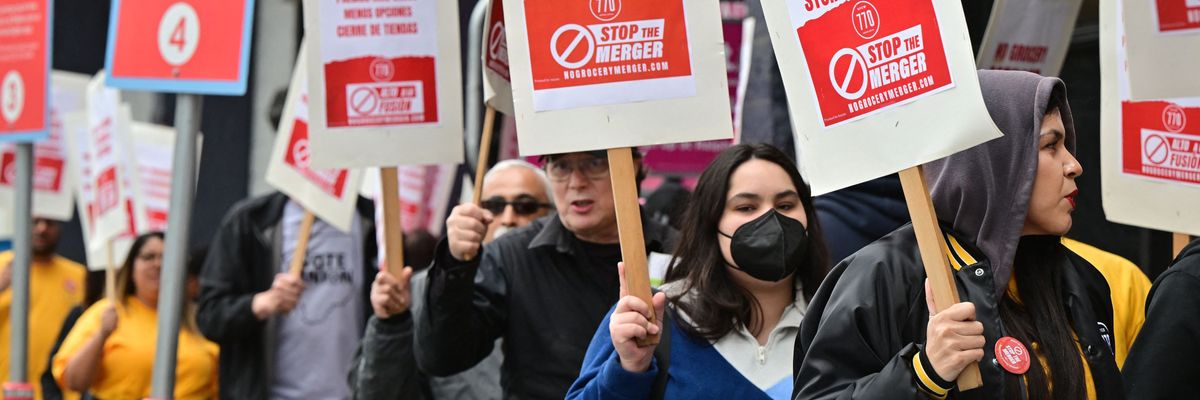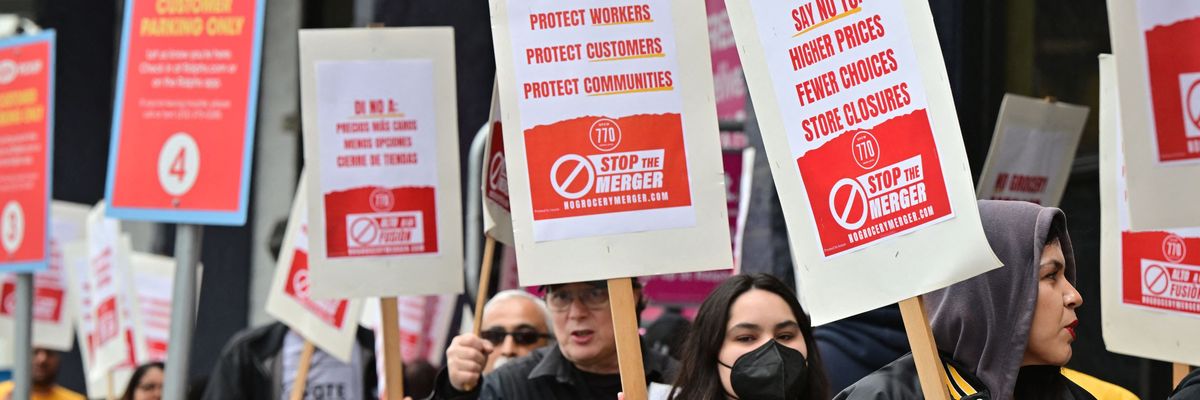Workers’ ability to negotiate better pay and working conditions rests on their capacity to switch jobs. By decreasing the number of outside options available to workers, the merger will limit competition.

Unionized grocery store workers rally to oppose the proposed merger between Kroger and Albertsons outside a Ralph's supermarket in Los Angeles on April 13, 2023, out of concern for less competition, increasing food prices and putting union jobs at risk.
(Photo: Frederic J. Brown/AFP via Getty Images)
BEN ZIPPERER
May 07, 2023
In October 2022, Kroger, the largest supermarket chain in the U.S., announced plans to acquire Albertsons, the second largest, for $24.6 billion—a deal that faces antitrust scrutiny from the Federal Trade Commission and state regulators. Historically, antitrust concerns have focused on the damage to consumers caused by concentration in product markets that gives large firms pricing power. However, a recent wave of economic research has called attention to potential damages to workers’ bargaining power over wages stemming from concentration in labor markets. In this policy memo, we discuss these labor market implications of the proposed merger. We find that the merger of two of the largest supermarket chains in the country will increase employer concentration and reduce the wages of all grocery store workers in affected cities across the country.
Workers’ ability to negotiate better pay and working conditions rests on their capacity to switch jobs. By decreasing the number of outside options available to workers, the merger will limit competition for hiring and retaining employees, and grocery store worker earnings will fall as a result. Crucially, the wage effects we identify are solely driven by this increase in labor market concentration. If the merger also leads to layoffs or hours cuts, this would add another dimension of damage to affected workers.
Our analysis uses grocery store employment and earnings data and the specific locations of Kroger and Albertsons stores. We find that:The merger will lower wages for 746,000 grocery store workers in over 50 metropolitan areas of the U.S. Increased concentration will suppress wages for all grocery store workers in affected cities—not only those workers currently employed by Kroger or Albertsons;
The total annual earnings of grocery store workers will fall by $334 million in affected metropolitan areas;
Because Kroger and Albertsons employ about one quarter of all grocery store employees, most of the wage losses caused by the merger will be a negative externality that falls on grocery store workers employed by other firms. On average, all grocery workers in affected markets will lose about $450 per year in wage income;
Earnings losses will be smaller in areas with a stronger union presence or a tighter labor market. In areas with weaker worker bargaining power, workers will experience larger wage declines; and
The expected earnings losses are a pure windfall for the employers. In our analysis, wages fall solely because of a change in labor market power brought about by increased concentration. Quantitatively, this windfall represents a significant transfer of income from wages to profits: The decrease in wages is equivalent to 2% of Kroger and Albertsons’ profits or three times the companies’ CEO compensation.
Analysis
Recent research has established that concentrated labor markets can reduce worker pay. As explained in Abdela and Steinbaum (2018), much of this research estimates the expected change in average wages for a given change in employer concentration in a particular industry- or occupation-specific labor market.
This analysis uses estimates from that research and applies them to labor markets, which we define as grocery store industry employers or employees in metropolitan areas using the 4-digit North American Industry Classification System (NAICS) industry 4451, Grocery and Convenience Retailers. For each of these metropolitan area labor markets, total grocery store wage losses are calculated by estimating percent changes in employer concentration due to the merger and multiplying those concentration changes by the wage responses estimated in the research literature described above.
To estimate the percent change in concentration due to the merger, we first estimate the level difference in the metropolitan area grocery store industry concentration before and after the merger and then divide that level change by an estimate of the baseline, pre-merger concentration.
On average, each of the affected 746,000 workers will lose about $450 in annual wage income.
To estimate the pre-merger concentration levels, we choose an average pre-merger concentration level by relying on the existing research literature that calculates trends in retail or grocery concentration. Measuring concentration as the Herfindahl-Hirschman Index (HHI) for 4-digit NAICS industries in commuting zones, Rinz (2022) found that the average HHI for the retail trade sector trended between 0.1 and 0.2 between 1976 and 2015. Zeballos, Dong, and Islamaj (2023) also calculated that the average HHI for two 6-digit industries associated with food retail markets in metropolitan areas rose from about 0.1 in 1990 to about 0.2 in 2019. In the following analysis, we choose a constant 0.15 as the average pre-merger concentration level in metropolitan areas for the grocery store industry. Coincidentally, 0.15 is the threshold at which the Department of Justice considers a market to be “moderately concentrated.”
In our analysis, the pre- and post-merger difference in concentration levels assumes Kroger and Albertsons act as two separate firms prior to the merger and as one single firm after the merger, and then we calculate the level change in HHI where it is possible to estimate store-level employment for each Kroger and Albertsons store. This estimate is a linear prediction based on a subset of 153 stores for which we have employment estimates, square footage data, and Quarterly Census of Employment and Wages (QCEW) metropolitan area-level average employment per establishment.
All told, this analysis covers 205 metropolitan areas containing 3,770 Kroger and Albertsons stores for which we can estimate store-level employment—and hence potential concentration changes—and for which we have 2022 QCEW data for baseline metropolitan area grocery store employment and earnings levels. According to the 2022 QCEW data, there are about 1.6 million grocery store workers in these cities and about 2.8 million grocery store workers nationwide. In 55 of these metropolitan areas, concentration will increase after the merger because these areas contain both Kroger and Albertsons stores.
Wages will fall on average for all grocery store workers in these areas due to the decrease in employer competition. (In other metropolitan areas, we assume there will be no wage change due to the merger because there is no estimated change in concentration.) The exact magnitude of the wage response is based on estimates published in Rinz (2022): Specifically, our analysis assumes that a 10% increase in concentration in a labor market will lower the average wage by 0.4%.
Table 1 summarizes the results. The metropolitan areas with concentration increases contain 746,000 grocery store workers, and the total annual wage bill is $26.3 billion. Across these areas, earnings-weighted average concentration will increase by 32% because of the merger. As a result, wages will decline by 1.3%, given the assumed elasticity of wages with respect to a concentration of -0.04. The Kroger-Albertsons merger will cause annual wages to fall in these affected cities by a total of $334 million. On average, each of the affected 746,000 workers will lose about $450 in annual wage income.
Because the wage losses will, on average, affect every grocery store worker in a metropolitan area where there is a merger of Kroger and Albertsons’ stores, cities with large grocery employment bases will experience particularly large losses in total wage income. Table 2 shows the 10 largest wage losses by metropolitan area. For example, the merger will cause annual grocery store wages to fall by $51 million in the Los Angeles-Long Beach-Anaheim, California, metropolitan area and $32 million in the Chicago-Naperville-Elgin, Illinois-Indiana-Wisconsin, metropolitan area
The effects described above represent average losses, and some individual workers may experience larger or smaller wage declines. In particular, the losses may be reduced in labor markets where workers have more bargaining power. Benmelech, Bergman and Kim (2022), in the case of manufacturing, and Prager and Schmitt (2021), in the case of hospital workers, show that the negative wage effects of employer concentration are larger in areas where union density is below average or right-to-work laws reduce unions’ bargaining power. For example, union coverage rates in the grocery store industry are only 8% in the South, but 20% in the Northeast.
As wage declines entail significant losses for grocery store workers, they simultaneously represent sizable parts of Kroger and Albertsons’ bottom lines. Some reports estimate total employment at Kroger and Albertsons to be about 710,000 workers, about one quarter of the total 2.8 million employees in the grocery store industry. Accordingly, a reasonable expectation for wage losses for employees at Kroger and Albertsons is one quarter of the $334 million, or about $84 million. Since Kroger’s profits were $2.3 billion and Albertsons profits were $1.5 billion in 2022, the merger-induced decline in grocery store worker wages is equivalent to about a 2% increase in Kroger and Albertsons’ profits. Because grocery profits were relatively high in 2022, the wage reductions would represent an even higher share of “normal” pre-pandemic profits. The wage losses also represent a significant windfall for company executives: Wage losses for workers at Kroger and Albertsons are about three times the size of the total CEO compensation of the two companies.
Conclusion
The Kroger and Albertsons merger will reduce the number of outside employment options available to workers and place downward pressure on grocery store workers’ wages. Based on existing empirical research showing the labor market effects of employer concentration, we find that the merger will permanently reduce the wages of 776,000 grocery store workers. Their annual earnings will fall by $334 million—about a $450 loss in annual wages per worker. If unionization rates were significantly higher in areas affected by the merger, union contracts and bargaining power could mitigate some of these losses.
For additional notes and references, see the original Economic Policy Institute report.
© 2023 Economic Policy Institute
BEN ZIPPERER is an economist at the Economic Policy Institute. His areas of expertise include the minimum wage, inequality, and low-wage labor markets. He has published research in the Industrial and Labor Relations Review and has been quoted in outlets such as the New York Times, The Washington Post, Bloomberg, and the BBC.
Full Bio >




